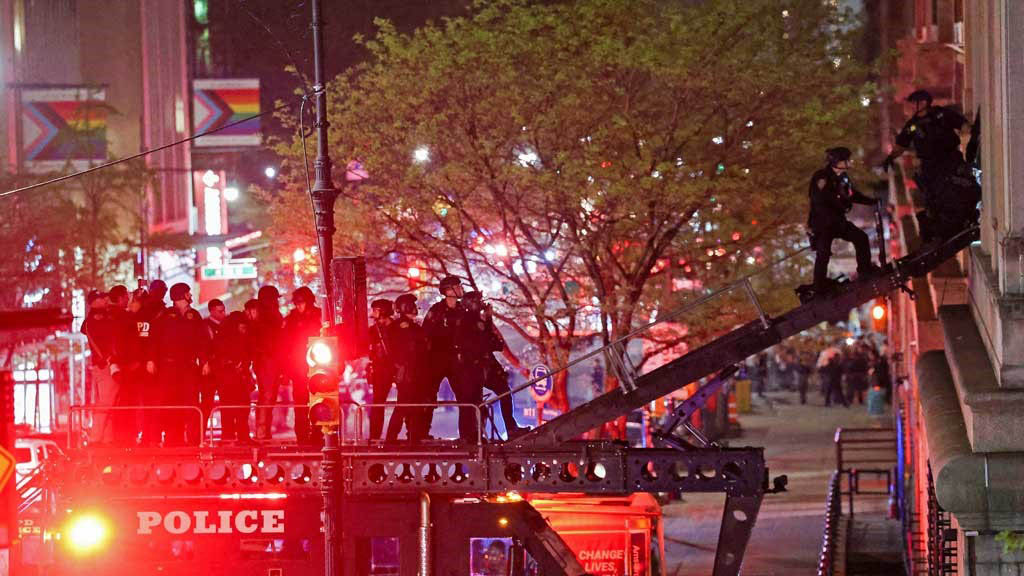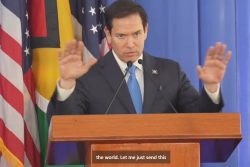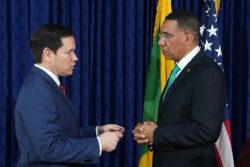NEW YORK, (Reuters) – New York City police officers entered the grounds of Columbia University last night to arrest and disperse pro-Palestinian protesters who took over a campus building nearly 24 hours earlier and have occupied a tent camp at the Ivy League school for nearly two weeks.
Live television images showed helmeted police in tactical gear entering the elite campus in upper Manhattan, which has been the focal point of student protests that have spread to dozens of schools across the U.S. in recent days expressing opposition to Israel’s war in Gaza.
“We’re clearing it out,” police officers yelled as they marched up to the barricaded entrance of Hamilton Hall, an academic building that protesters had broke into and seized control of in the early morning hours of Tuesday.
A long line of police officers were seen climbing into the building through a second-story window, using a vehicle with a ladder to gain access to the upper floor.
Dozens of other officers swarmed over the nearby protest encampment, as onlooking students standing just outside the campus jeered them with shouts of “Shame, shame!” Before long, officers were seen leading handcuffed protesters to police vehicles outside campus gates.
Police boarded about 50 detainees onto a bus, each of them with their hands bound behind their backs by zip ties, the entire scene illuminated with flashing red and blue lights of police vehicles. Ambulances and other emergency services vehicles stood at the read.
“Free, free, free Palestine,” chanted protesters outside the building. Others yelled “Let the students go”.
Columbia University officials earlier on Tuesday threatened academic expulsion of the students who seized Hamilton Hall.
The occupation began overnight when protesters broke windows, stormed inside and unfurled a banner reading “Hind’s Hall,” symbolically renaming the building for a 6-year-old Palestinian child killed in Gaza by the Israeli military.
Outside the eight-story, neo-classical building – the site of various student occupations on the campus dating back to the 1960s – protesters had blocked the entrance with tables, linked arms to form a barricade and chanted pro-Palestinian slogans.
At an evening news briefing held a few hours before police entered Columbia, Mayor Eric Adams and city police officials said the Hamilton Hall takeover was instigated by “outside agitators” who lack any affiliation with Columbia and are known to law enforcement for provoking lawlessness.
Police said they based their conclusions in part on escalating tactics in the occupation, including vandalism, use of barricades to block entrances and destruction of security cameras.
Adams suggested some of the student protesters were not fully aware of “external actors” in their midst.
“We cannot and will not allow what should be a peaceful gathering to turn into a violent spectacle that serves no purpose. We cannot wait until this situation becomes even more serious. This must end now,” the mayor said.
One of the student leaders of the protest, Mahmoud Khalil, a Palestinian scholar attending Columbia’s School of International and Public Affairs on a student visa, disputed assertions that outsiders had initiated the occupation.
“They’re students,” he told Reuters.
A day earlier, the university said it had begun suspending students who defied a deadline for vacating a protest encampment, as school officials declared that several days of talks with protest leaders aimed at dismantling the tents had reached a stalemate.
“Disruptions on campus have created a threatening environment for many of our Jewish students and faculty and a noisy distraction that interferes with the teaching, learning and preparing for final exams,” the university said in a statement on Tuesday.
The Oct. 7 attack on southern Israel by Hamas militants from Gaza, and the ensuing Israeli offensive on the Palestinian enclave, have unleashed the biggest outpouring of student activism since the anti-racism protests of 2020.
Many of the demonstrations have been met with counter-protesters accusing them of fomenting anti-Jewish hatred. The pro-Palestinian side, including Jews opposed to Israeli actions in Gaza, say they are being unfairly branded as antisemitic for criticizing Israel’s government and expressing support for human rights.
In dealing with the protests, university officials have struggled to strike a balance between allowing freedom of expression and stamping out hate speech.
The issue has taken on political overtones in the run-up to the U.S. presidential election in November, with Republicans accusing some university administrators of turning a blind eye to antisemitic rhetoric and harassment.
White House spokesperson John Kirby on Tuesday denounced non-peaceful forms of student protests, calling the occupation of campus buildings “the wrong approach.”
New York Police Department officials had stressed before Tuesday night’s sweep that officers would refrain from entering the campus unless Columbia administrators invited their presence, as they did on April 18, when NYPD officers removed an earlier encampment. More than 100 arrests were made at that time, stirring an outcry by many students and staff.
Dozens of tents, pitched on a hedge-lined grassy area – beside a smaller lawn since planted with hundreds of small Israeli flags – were put back up days later and remained on campus through Tuesday.









